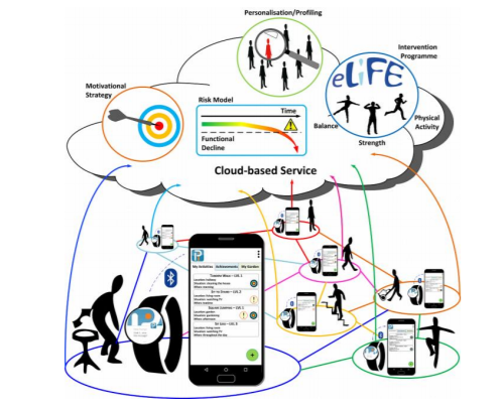Objectives
PreventIT sees modern developments in mobile technology as an excellent starting point to enable active and healthy ageing, and therefore aims to develop a personalised behavioural change intervention at the time of retirement that is based on exercises and activities that are embedded into daily life. In order to realize this ambitious aim, PreventIT brings together a strong consortium with partners from several European research institutions, academic hospitals, and companies that together have the necessary skills and experience to bring this project to fruition.
The Research
The main aim of the project is to develop and test a personalized ICT based intervention aimed at behavioral change in people who have recently retired, in order to decrease risk for age-related functional decline. We will target the consumer market, and not the health care system. The intervention consists of small bouts of exercise integrated in daily life, where wearable sensors (a smartphone and a wrist watch) are used to give feedback on physical behavior, motivate for further activity, and socialize with others. The main outcome from the study is a complexity metrics for physical behavior derived from monitoring of physical activity and sleep by use of body worn sensors. A cloud based platform will be established to communicate and store information of the sensing systems. User interfaces aimed at older people will be developed. Motivation for exercise, usability of ICT solutions, use of unobtrusive technology, and data protection will be paid particular attention. The project also aims to develop tools for monitoring and assessing physical behavior, using data from body worn sensor systems.

Focus of WP7 (led by LMAM)
The technical aim of this WP is to establish a methodological tool to provide a comprehensive assessment and modelling of behavioural pattern in every-day life. The scientific and clinical aim is to explore the link between complexity of behaviour and subjects’ functional ability as well as the implications this link may have for detection and prevention of functional decline related to ageing. We hypothesise that PA complexity metrics, which integrate multiple dimensions of activity/movement features (type, intensity, duration, frequency, dynamics)¹ along with patterns of sleep and social behaviours can provide an objective, global index allowing a comprehensive assessment of lifestyle behaviour.